Scientific Area » Longobard Culture » Religion
« Back
RELIGION
The concept of Europe was devised thanks to both the Greek Roman and the barbarian civilizations in all their expressions: Goths, Ostrogoths, Vandals, Burgundes, Alemanni, Longobards. Barbarian peoples, in religious terms, replaced their heathen worship with a sort of Christianity which was at first pretty vague, then Aryan and lastly Catholic.
 |
 |
Fram Wodan to Archangel Michael |
|
The heathen Goths, for example, were converted to Aryan Christianity. Aryanism spread above all because of the Aryan mission of bishop Ulfilas (311-382), who translated the Bible into his Gothic alphabet: it was the first relevant Germanic document. Though Christians, particularly prisoners, mingled with Barbarians even before the apostleship of Ulfilas.
Ulfilas’ doctrine of God the Father, the creator the Only-Begotten Son who in his turn created the world, was not only more comprehensible for the Germanic mentality than the Catholic doctrine of God, One substance and Three persons, but also more faithful to the original religion of the Germans. These latter, indeed, praised in their National chants their main god Tristan, whose son Mannus was the founder of the Germanic gens.
Vandals and Burgundes were also converted to Aryanism, which became the principle of their National identity: thus, the conversion to Aryanism had a political aim, as it looked like a distinguing mark from a nationalist point of view towards the Roman Empire. It became the official creed of the Visigoths settled in the Roman Catholic regions of Southern Gaul and Spain, the Vandals who invaded Roman Catholic Africa and the Ostrogoths settled in Italy.
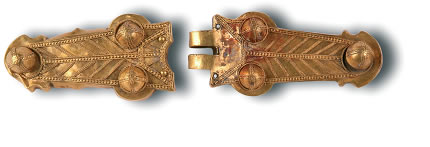
In 568 the Longobards, hostile to Constantinople’s Empire that had relieved Italy over the previous years, invaded the Italian peninsula as Christians of the Catholic faith (they were converted to Catholicism under the apostleship of St. Severine within the Byzantine - Longobard foedus as they were settled in Noricum). Heathen and Aryan currents persisted, though: the Longobard Heathenism, indeed, left such traces in different Italian cities and towns as Longobard gods and mythical figures (Wodan, Frea, Gambara, Ybor, Aio) depicted in a manuscript miniature of the year 1,000 discovered in Cava dei Tirreni; the Beneventan legend of the witches’orgiastic dance around the walnut tree with the devil having the appearance of a he-goat is the Christian interpretation of both the ritual of the unbridled sarabanda around the walnut tree by the Longobards worshipping Wotan and their arrow-piercing through the he-goat’s skin hanging on that tree. The Longobards worshipping Wotan left their traces in the name of “Votani” attested in the Tiburtine area.
Alboin’s choice of Aryanism on his arrival in Italy, in order to distinguish or to set himself against the Roman Catholic Empire of Constantinople contributed to the progress of this doctrine among his subjects. However, after many decades, the Longobards had not yet adopted a single religion.
During the first period spent in Italy the Longobards were influenced by Theodelinda, who was converted to Christianity before arriving in Italy as the bride of Longobards’ king Authari (584-590). After his death she was married by his successor Agilulf (590-616), a deeply religious person.
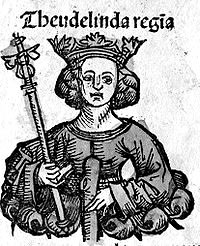
In Paul the Deacon’s view, Theodelinda contributed much to the spread of Catholicism among the Longobards settled in Italy, even though not at an official level. The religiousness of the queen led to the production of many works including the building of a church dedicated to John the Baptist in Monza, the restoration of other churches and many donations of assets to sacred places. Such a determined and religious queen openly professing the Roman creed wielded a Catholic and pro-Roman influence on the Longobards in her time. Moreover, thanks to her action Agilulf, Pope Gregory the Great and the Byzantines were finally reconciled. Urged by his wife, Agilulf himself was converted to Catholicism and gave back a number of assets stolen by his people to the Church.
However much had still to be done for the Longobards to adopt a single religion. Whereas both theVisigoths and the Franks were officially converted to Catholicism after the conversion of Reccared I and Clovis, the Longobards, despite their royal family was Catholic, kept on professing Aryanism and Heathenism.
Although its spread was a gradual process, Catholicism was definitively affirmed after the abolition of Aryanism by Aripert I -and after him by Perctarit (671-688)- who, irrespective of the duces and the people’s assembly and contrary to what Alboin and his successors did, autonomously decided to establish a new religion.
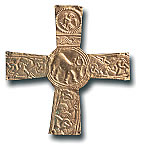


Later, King Cunipert (688-700) had a synod celebrated in Pavia, at that time the capital of the Longobard kingdom, in order to put an end to the schism related to the Three Chapters. Through the Council of Pavia (698) Catholicism became the single official religion for the Longobards. However, beside their religiousness, the Longobard élites were attracted to Christianity as it was the official religion of the Roman Empire, a political and institutional system which, in their view, was superior to theirs and deserved to be used in all its aspects as a tool of social promotion.
Many churches and monasteries were built mainly in Pavia, but also elsewhere at the will of sovereigns and dukes. Generous donations of different kinds were made by Longobard leaders to monasteries and convents; Paul the Deacon wrote that Longobard principes (princes) donated land properties to the almost popular abbey of Bobbio, as did duke of Benevento Gisulf II by donating churches, lands and monasteries to the founders of the monastery of San Vincenzo al Volturno.
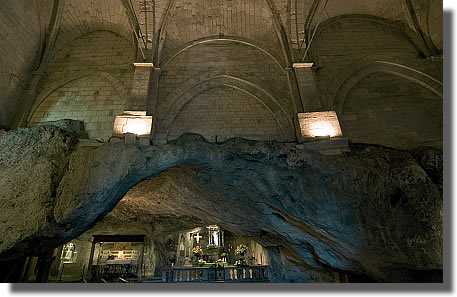
The cave-Sanctuary monumentalized in Monte Sant’Angelo
As to the Christian religion, the Longobards decisively contributed to the evolution of a number of cults, including those related to war which were suitable for Longobards’ sensitiveness and fantasy. In particular, the deep and centuries-old relationship between the Longobards of Benevento and, later, Pavia and the cult of St. Michael in Gargano which contributed to developing the warrior nature of the saint. Moreover, the particular relationship between the Longobards of Benevento, the cult of the Archangel and the Apulian shrine contributed to make St.Michael and the Apulian cave respectively the official saint and shrine of the Longobards.
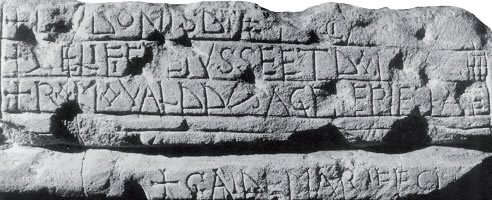
Some epigraphs of 7th-8th century on the shrine structure depicting either characters of the Longobard dynasty of Benevento (Grimoald, Romuald I, Romuald II) and Pavia (Perctarit, Cunipert), or explicitly the almost Nicene- Catholic character of their faith, the cult of Archangel Michael certainly affected the Longobard transition from Aryanism to Catholicism.
« Back


